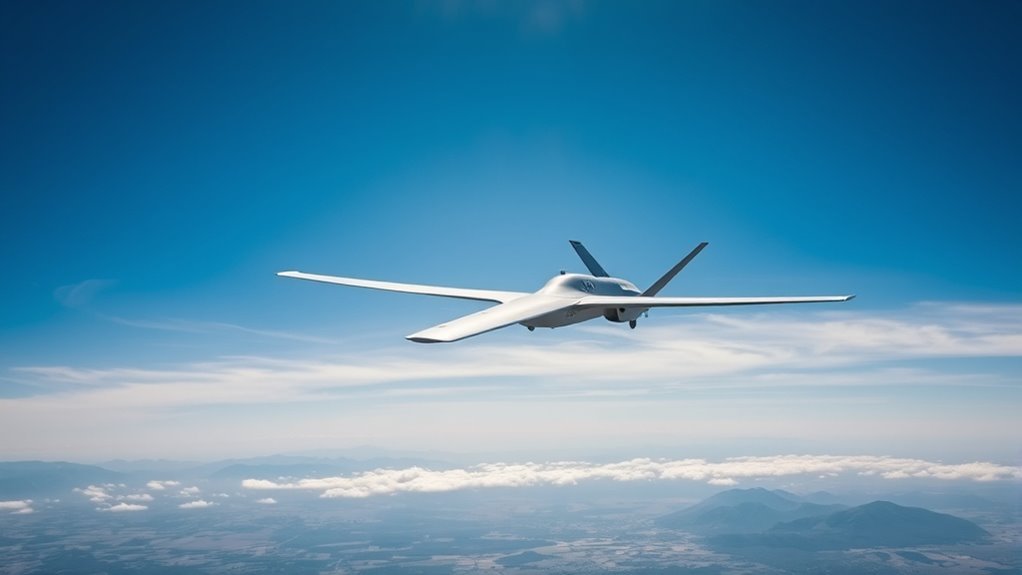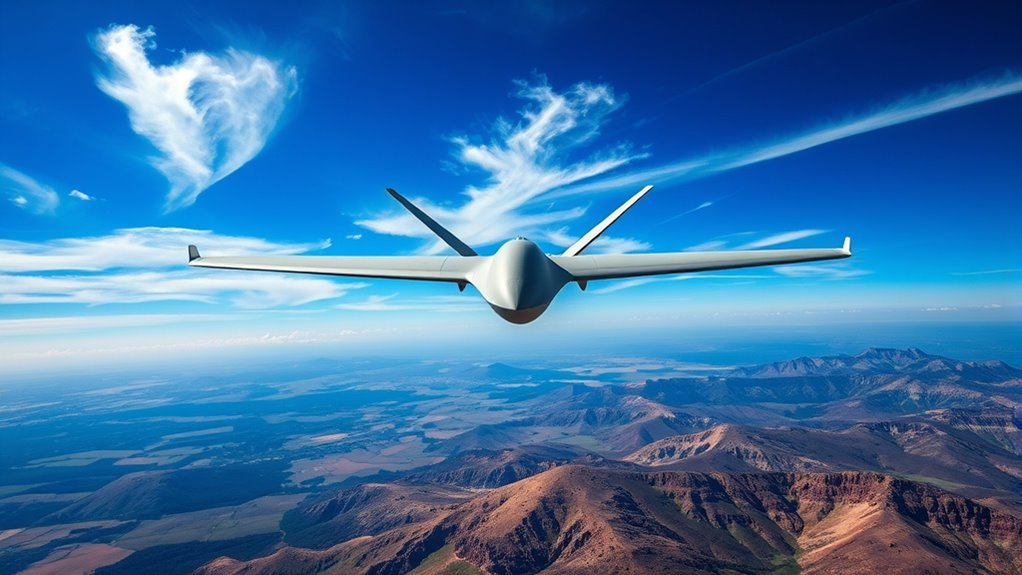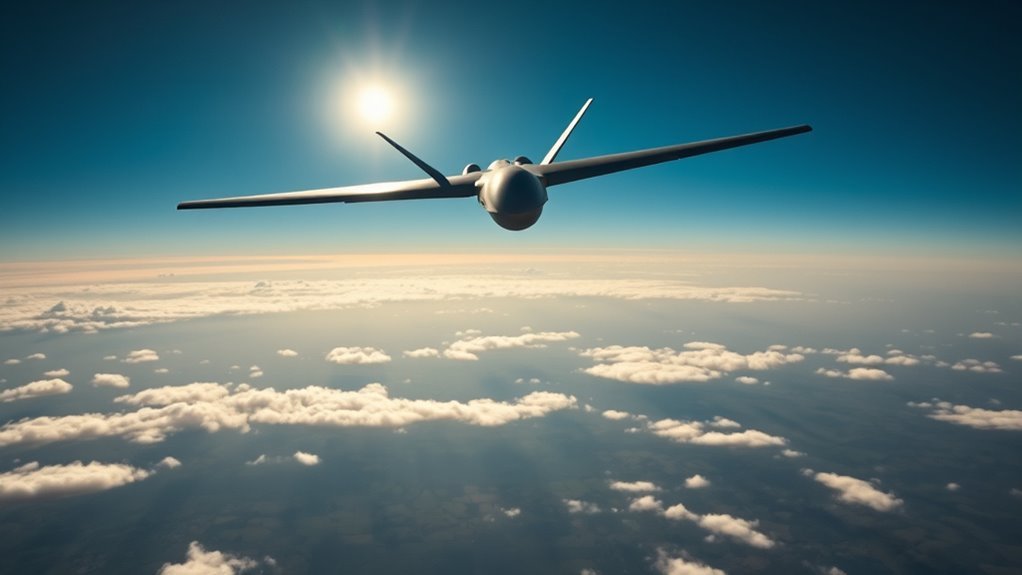Military drones operate at various altitudes, typically flying below 10,000 feet for low-altitude surveillance missions and above 30,000 feet for high-altitude reconnaissance. These operational heights allow drones to gather critical intelligence while minimizing detection by enemy radar systems. Factors like drone weight, weather conditions, and design optimization directly influence their performance and altitude capabilities. Understanding these aspects reveals the complexities of drone operations and their strategic significance in modern warfare, leading to advancements in technology.
Types of Military Drones

Military drones, often referred to as unmanned aerial vehicles (UAVs), come in various types, each designed for specific missions and operational needs. Among them, combat drones play a vital role in modern warfare, equipped with precision weaponry to engage targets with minimal risk to personnel. Their capabilities allow for real-time decision-making in high-stakes environments. On the other hand, surveillance drones are essential for intelligence gathering and reconnaissance, providing critical data and situational awareness without endangering human lives. These UAVs utilize advanced sensors and imaging technology, enabling you to monitor vast areas effectively. Understanding the distinctions between combat and surveillance drones helps you appreciate their strategic significance in maintaining security and operational effectiveness in the ever-evolving landscape of military engagements.
Operational Altitudes of Different Drones

When considering operational altitudes, it’s essential to differentiate between low-altitude surveillance drones and high-altitude reconnaissance drones. Low-altitude drones typically operate under 10,000 feet, focusing on detailed ground imagery and tactical support. In contrast, high-altitude drones can reach altitudes above 30,000 feet, enabling broad area surveillance and intelligence gathering with minimal risk of detection.
Low-Altitude Surveillance Drones
Low-altitude surveillance drones typically operate at altitudes ranging from 500 to 15,000 feet, allowing them to capture detailed imagery while remaining under the radar of conventional air defense systems. These drones leverage their low altitude capabilities to enhance the quality of reconnaissance, providing actionable intelligence for strategic decision-making. When you consider drone deployment, these platforms excel in urban environments or sensitive areas where high-altitude drones may be detected easily. Their agile maneuverability at lower elevations enables them to adapt to changing operational scenarios, ensuring effective surveillance missions. By maintaining a discreet presence, these drones contribute greatly to maintaining freedom, enabling forces to monitor and respond to threats without the constraints of traditional aerial reconnaissance.
High-Altitude Reconnaissance Drones
High-altitude reconnaissance drones are designed to operate at considerably greater altitudes, typically ranging from 15,000 to 65,000 feet, enabling them to cover vast areas while evading detection from ground-based air defense systems. These drones exhibit impressive high altitude capabilities, making them essential for strategic reconnaissance missions. By flying above the majority of commercial air traffic and hostile threats, they gather vital intelligence without risking personnel or manned aircraft. The ability to maintain prolonged flight durations at such elevations enhances their effectiveness in monitoring enemy movements and evaluating battlefield conditions. Understanding the operational altitudes of these drones is fundamental for grasping their role in modern military operations, providing a tactical advantage during reconnaissance missions that can markedly influence the outcome of engagements.
Factors Influencing Drone Altitude

Although various factors dictate how high military drones can fly, operational requirements and environmental conditions play vital roles in determining their ideal altitude. You’ll find that drone weight greatly impacts performance; heavier drones may struggle to reach ideal heights, while lighter models can ascend more easily. Additionally, weather conditions, such as wind speed and temperature, can affect lift and stability. For instance, high winds might necessitate a lower altitude to maintain control, while adverse weather could limit operational effectiveness altogether. Furthermore, understanding signal attenuation is crucial for optimizing drone flight paths, as it can significantly impact the drone’s communication capabilities at various altitudes. Consequently, understanding these factors is fundamental for maximizing the drone’s capabilities. Essentially, balancing drone weight against fluctuating weather conditions guarantees that you achieve the desired altitude while maintaining mission integrity. Furthermore, real-time monitoring of flight dynamics ensures that drones can adapt to changing conditions and maintain optimal performance.
Advantages of High-Altitude Operations
High-altitude operations greatly enhance your surveillance capabilities by providing a broader field of view and improved target detection. Additionally, flying at elevated altitudes reduces the risk of detection from enemy radar systems, ensuring stealthier missions. This operational altitude also extends your range, allowing for longer durations of surveillance and engagement without the need for frequent refueling.
Enhanced Surveillance Capabilities
As military operations increasingly rely on advanced technology, the ability to conduct surveillance from elevated altitudes offers significant advantages. High-altitude operations enable persistent aerial reconnaissance, allowing you to gather intelligence over vast areas without being constrained by ground obstacles. Drones operating at these altitudes can cover extensive geographic regions, providing real-time data essential for informed decision-making. The high vantage point enhances your situational awareness, facilitating the detection of enemy movements and infrastructure. Furthermore, these drones are equipped with sophisticated sensors capable of capturing high-resolution imagery, which is crucial for precise intelligence gathering. Overall, high-altitude surveillance not only improves operational effectiveness but also empowers you to maintain an edge in contemporary military engagements, ensuring timely and accurate information.
Reduced Detection Risk
When drones operate at elevated altitudes, they greatly reduce the risk of detection by enemy forces. By leveraging advanced stealth technology, these unmanned aerial vehicles become less visible to radar systems. The combination of altitude and design minimizes the radar cross-section, enhancing radar evasion capabilities. This allows drones to conduct missions without raising alarm, providing strategic advantages in surveillance and reconnaissance operations. Operating high above ground level not only keeps them out of the reach of many ground-based defenses but also allows them to gather intelligence with minimal interference. Consequently, the reduced detection risk guarantees that your operations can proceed with greater freedom and effectiveness, ultimately supporting mission objectives without compromising safety.
Extended Operational Range
Operating at elevated altitudes allows military drones to considerably extend their operational range, enabling them to cover larger areas without the limitations faced by lower-flying aircraft. High-altitude operations enhance extended flight capabilities, contributing to greater operational efficiency. By flying above weather disturbances and potential threats, drones can maintain consistent surveillance and reconnaissance missions.
| Advantage | Description |
|---|---|
| Greater Coverage | Access to vast areas, reducing mission time. |
| Enhanced Fuel Efficiency | Optimized flight paths minimize fuel consumption. |
| Improved Surveillance | Long-range sensors operate effectively at altitude. |
| Reduced Vulnerability | Limited exposure to ground-based threats. |
These factors collectively empower military drones to perform strategic objectives with precision, aligning with a mission for freedom and security.
Limitations and Challenges at High Altitudes
While military drones have the capability to reach impressive altitudes, they encounter several limitations and challenges that can impact their operational effectiveness. At high altitudes, altitude effects can lead to decreased engine performance and reduced lift, which limits flight duration and maneuverability. Additionally, the thinner atmosphere can hinder sensor functionality and communication systems, resulting in compromised data transmission and target acquisition. Furthermore, drones like the AeroVironment Wasp are optimized for lower altitudes, where their design can fully exploit aerodynamic efficiency. Altitude limitations also include increased vulnerability to extreme weather conditions, such as high winds and turbulence, which can destabilize the drone. These factors necessitate careful planning and consideration when deploying drones in high-altitude operations, ensuring that you maximize their capabilities while mitigating the inherent risks associated with operating in such environments. Furthermore, robust wind resistance, as seen in the Mavic Pro, is essential for maintaining stability during high-altitude missions.
Future Trends in Drone Technology and Altitude Capabilities
As advancements in drone technology continue to evolve, the future of military drones is poised to redefine altitude capabilities considerably. With enhanced autonomous navigation systems, drones will navigate complex environments at unprecedented heights, increasing operational effectiveness. Innovations in materials will enable lighter frames, allowing for greater payload optimization, which means you can carry more equipment without sacrificing altitude performance. Expect drones to integrate advanced AI algorithms, improving their ability to adapt to dynamic conditions in real-time. This not only expands their operational range but also enhances mission versatility. As these trends unfold, you’ll see military drones operating above traditional limits, pushing boundaries and enhancing strategic advantages in modern warfare. The cutting-edge innovation in drone technology is set to further revolutionize the capabilities of military drones. By 2025, these drones will also feature AI-driven autonomous navigation for safer and more efficient operations. The skies are about to become a new frontier.
Frequently Asked Questions
What Are the Legal Regulations for Military Drone Flight Altitudes?
Imagine soaring through the skies, but drone regulations impose altitude restrictions. You must navigate a labyrinth of laws, balancing operational freedom with safety, ensuring compliance while exploring the vast possibilities of drone flight within set boundaries.
How Do Weather Conditions Affect Military Drone Flying Capabilities?
Weather conditions greatly impact military drone operations, affecting altitude limitations. High winds, precipitation, and visibility can restrict flight capabilities, necessitating adjustments to mission parameters to guarantee safety and operational effectiveness in diverse environments.
Can Drones Be Operated Beyond Visual Line of Sight?
Yes, you can operate drones beyond visual line of sight, utilizing autonomous navigation systems. However, operational limitations like regulatory compliance and technical challenges must be addressed to guarantee safety and effectiveness in diverse environments.
What Are the Maintenance Requirements for High-Altitude Drones?
High-altitude drones require meticulous attention! You’ll need regular drone inspections and strict adherence to maintenance schedules to guarantee they soar smoothly. Ignoring these could ground your dreams of aerial freedom and efficiency in no time!
How Do Military Drones Communicate at High Altitudes?
Military drones utilize advanced data transmission systems and altitude sensors to maintain communication at high altitudes. These technologies guarantee reliable connectivity, allowing you to control operations and gather intelligence effectively, even in challenging environments.

